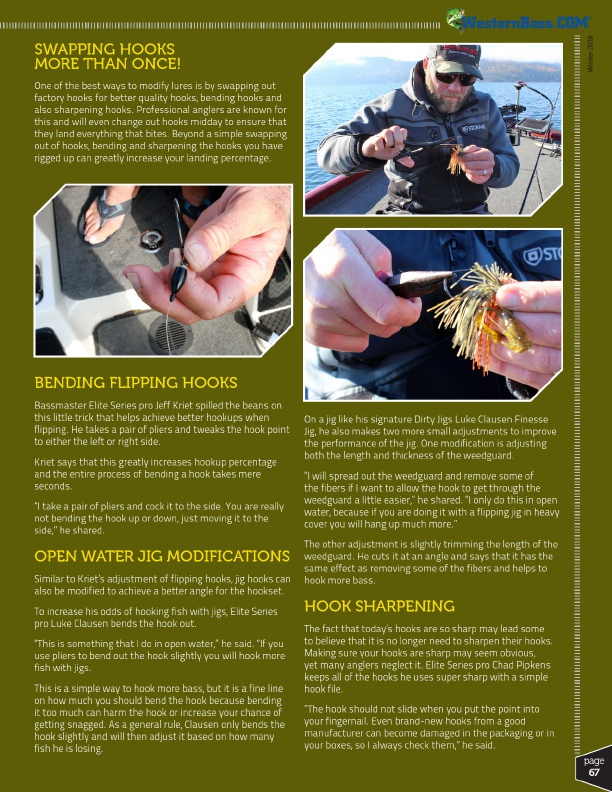
Winter 2018
SWAPPING HOOKS MORE THAN ONCE!
One of the best ways to modify lures is by swapping out factory hooks for better quality hooks, bending hooks and also sharpening hooks. Professional anglers are known for this and will even change out hooks midday to ensure that they land everything that bites. Beyond a simple swapping out of hooks, bending and sharpening the hooks you have rigged up can greatly increase your landing percentage.
®
BENDING FLIPPING HOOKS
Bassmaster Elite Series pro Jeff Kriet spilled the beans on this little trick that helps achieve better hookups when flipping. He takes a pair of pliers and tweaks the hook point to either the left or right side.
Kriet says that this greatly increases hookup percentage and the entire process of bending a hook takes mere seconds.
“I take a pair of pliers and cock it to the side. You are really not bending the hook up or down, just moving it to the side,” he shared.
OPEN WATER JIG MODIFICATIONS
Similar to Kriet’s adjustment of flipping hooks, jig hooks can also be modified to achieve a better angle for the hookset.
To increase his odds of hooking fish with jigs, Elite Series pro Luke Clausen bends the hook out.
“This is something that I do in open water,” he said. “If you use pliers to bend out the hook slightly you will hook more fish with jigs.
This is a simple way to hook more bass, but it is a fine line on how much you should bend the hook because bending it too much can harm the hook or increase your chance of getting snagged. As a general rule, Clausen only bends the hook slightly and will then adjust it based on how many fish he is losing.
On a jig like his signature Dirty Jigs Luke Clausen Finesse Jig, he also makes two more small adjustments to improve the performance of the jig. One modification is adjusting both the length and thickness of the weedguard.
“I will spread out the weedguard and remove some of the fibers if I want to allow the hook to get through the weedguard a little easier,” he shared. “I only do this in open water, because if you are doing it with a flipping jig in heavy cover you will hang up much more.”
The other adjustment is slightly trimming the length of the weedguard. He cuts it at an angle and says that it has the same effect as removing some of the fibers and helps to hook more bass.
HOOK SHARPENING
The fact that today’s hooks are so sharp may lead some to believe that it is no longer need to sharpen their hooks. Making sure your hooks are sharp may seem obvious, yet many anglers neglect it. Elite Series pro Chad Pipkens keeps all of the hooks he uses super sharp with a simple hook file.
“The hook should not slide when you put the point into your fingernail. Even brand-new hooks from a good manufacturer can become damaged in the packaging or in your boxes, so I always check them,” he said.
page
67